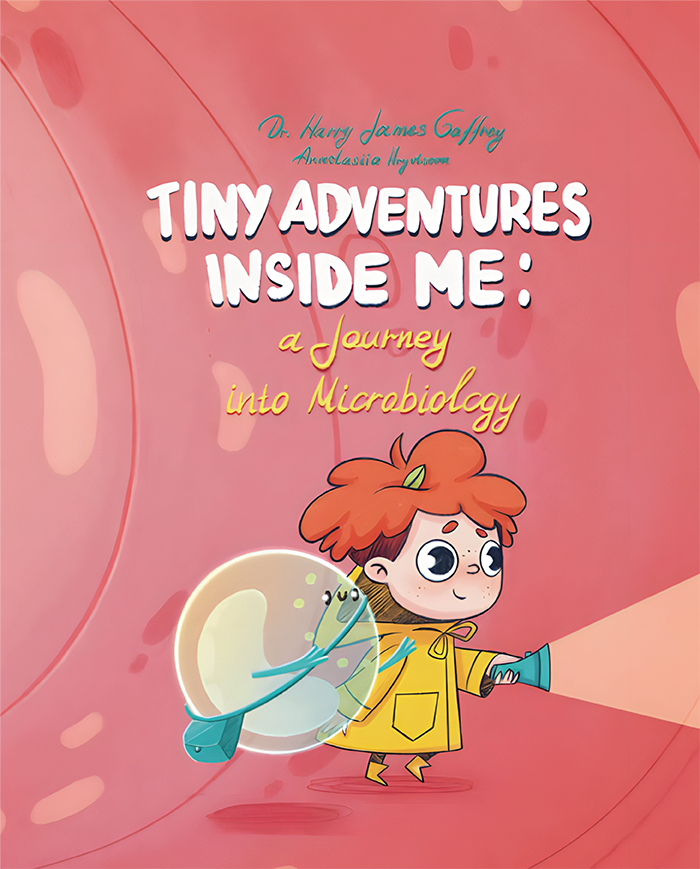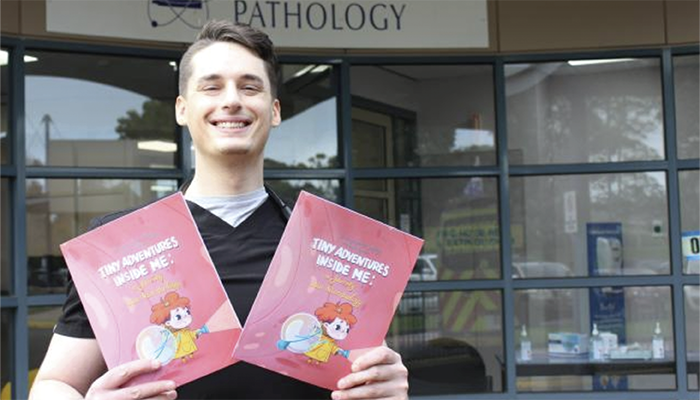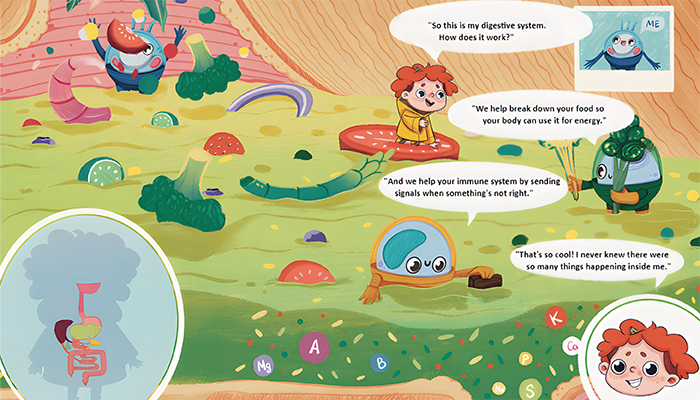
Children are inquisitive by nature, but when it comes to explaining complicated aspects of the world, parents and caregivers are often stuck at a crossroads. Microbiology is one such area – how do you explain the roles of microbes, bacteria, and the gastrointestinal system to someone who hasn’t reached double digits in age?
This is the challenge Harry James Gaffney approached head on when creating his first children’s book, “Tiny Adventures Inside Me.” Here, we speak with Gaffney to learn more about bringing pathology and microbiology to a younger audience.
What first interested you in pathology and how did you end up working in the field?
My journey into pathology began quite early during my first year of medical school, with a lecturer whose passion for the field was infectious. This enthusiasm inspired me to delve deeper into pathology and seriously consider it as a career path. From here, I took a rotation in pathology during medical school and found myself captivated by the meticulous process of examining slides and understanding the intricate architecture of normal histology. The intellectual challenge of deciphering histological patterns was fascinating, and I found immense satisfaction in the hands-on experience of working in the lab.
As I gained more experience in the field, my passion for pathology solidified – combining my love for microscopic details with my desire to contribute to patient care through diagnostic precision.

Where did the idea for Tiny Adventures Inside Me come from?
I've always harbored a dream of becoming a children's book author, and my deep love for microbiology and pathology provided the perfect foundation for this endeavor. One particular day, I thought to myself, "Why not combine my professional passions with my creative aspirations?" The concept of creating an accessible pathway for children and families to learn about their bodies and the microscopic world within was incredibly appealing to me.
I wanted to create a story that was not only entertaining but also educational. The idea of a child shrinking down to the size of a microbe and exploring their own body with the help of friendly microbial guides was both imaginative and informative. It allowed me to present complex scientific concepts in a fun and engaging way, fostering curiosity and a love for science among young readers. The book became a way for me to share my passion for microbiology and pathology while making these subjects accessible and enjoyable for children.

Tell us a little bit about the book’s plot – how much is pathology and microbiology rooted in the narrative?
"Tiny Adventures Inside Me" follows the exciting story of a child who, while playing outside, discovers a magical shrink orb that reduces them to the size of a bacterium. This sudden transformation plunges the child into an adventurous journey within their own body. Guided by a friendly and knowledgeable neutrophil, the child explores various body systems – uncovering the intricate relationships between human body systems and microorganisms.
The narrative is deeply rooted in microbiology and anatomical pathology. Throughout the story, the child encounters various microbes, including bacteria and viruses, learning about their roles in maintaining health and fighting infections. They travel through different body systems, such as the respiratory and gastrointestinal systems, where they witness firsthand how cells and microbes interact to sustain health. Though the book doesn’t delve into histology (something I wish I had included in hindsight) it effectively weaves together elements of microbiology and pathology, creating a rich, educational story that’s both fun and informative.
What's the target audience age range, and what techniques have you used to simplify the science?
The target age range for "Tiny Adventures Inside Me" is up to eight years old. To make the science accessible to this young audience, I employed several techniques to simplify complex concepts without sacrificing educational value. Firstly, the text is minimal yet informative, ensuring it was easy for parents to read aloud to their children and spark meaningful discussions about healthy habits and the inner workings of the human body.
The illustrations play a crucial role in simplifying the science and making it engaging for young readers. The artwork is vibrant and detailed, allowing children to visually explore the microscopic world within their bodies. I also included interactive elements, such as "find me" sections, where children can search for specific microbes or cells within the illustrations. These interactive features reinforce learning by encouraging children to actively participate in the story.
Additionally, I used analogies and relatable scenarios to explain scientific concepts in a way that young children can understand. By comparing the body’s immune cells to friendly guardians and microbes to tiny helpers, the information becomes more relatable and easier to grasp. By combining simple text, interactive elements, and relatable analogies, I aimed to create a book that is both educational and enjoyable for young readers and their families.
Why did you decide to write for a younger audience rather than teenagers or students?
Writing for a younger audience was a natural choice for me because I have a strong passion for promoting health education as early as possible. I firmly believe that prevention is better than cure and educating children about how their bodies function, the role of microbes, and the importance of healthy habits is the most upstream approach to health education. By teaching young children about these concepts, we can instill healthy habits early on and set the foundation for a healthier future.
Additionally, younger children are naturally curious and enthusiastic learners who enjoy interactive and imaginative stories, making them the perfect audience for a book like "Tiny Adventures Inside Me." Writing for this age group allows me to introduce them to the wonders of microbiology and pathology in a fun and engaging way, inspiring a lifelong interest in science and health.
I hope that by making the information accessible and enjoyable, this story empowers families to discuss topics related to health, hygiene, and the microscopic world in a way that is engaging and meaningful for young children.

Is there anything in particular that you believe is missing from the way pathology is taught across the curriculum – and if so, how can we amend this?
One significant area that I believe is missing from the current pathology curriculum is the integration of histology and pathology into clinical rotations. Typically, histology is taught in the preclinical years, and many medical students tend to forget much of what they learned by the time they enter their clinical rotations. To address this gap, I think it is better to integrate histology and pathology into the medical school curriculum – specifically during surgical rotations.
Medical students on surgical rotations could benefit immensely from attending biopsies and frozen sections before following the samples to the pathology lab to observe their preparation and evaluation. This hands-on experience would help students understand the critical role that pathology plays in guiding diagnostic reasoning and clinical decision-making. By witnessing the entire process, from tissue sampling to pathological analysis, students would gain a deeper appreciation for the synergistic relationship between pathologists and surgeons.
This integrated approach would not only enhance students' understanding of pathology, but also improve their ability to correlate clinical information with histological findings. It would foster a more comprehensive and practical understanding of how pathology informs patient care. By incorporating these changes into the curriculum, we can better prepare future medical professionals to utilize pathology effectively in their clinical practice.
What are your plans for the future?
My primary focus is advancing my career and becoming the best pathologist I can be. I am dedicated to continuously learning and growing in my field, and I am excited about the opportunities that lie ahead. However, my passion for writing and educating young minds remains strong, and I hope to continue creating more books that combine my love for pathology and microbiology with engaging storytelling.
I have several ideas for future projects that delve deeper into specific aspects of histology and pathology. My goal is to create a series of books that not only entertain but also educate young readers about the fascinating world of science and the human body. By sharing my knowledge and passion through these books, I hope to inspire the next generation of scientists, doctors, and health enthusiasts.
In addition to writing, I am also interested in exploring other avenues for education and outreach, such as interactive workshops, online resources, and collaborations with schools and educational institutions. The journey of learning and teaching is ongoing, and I am excited to see where it takes me.
Any final thoughts?
I'd like to emphasize the importance of curiosity and continuous learning. Whether you are a medical professional, a parent, or a child, never stop exploring and asking questions. Our bodies are incredible, complex systems and a better understanding can lead to healthier, more informed lives. Embrace the wonders of science and the joy of discovery, and don't hesitate to share your knowledge and passion with others.




